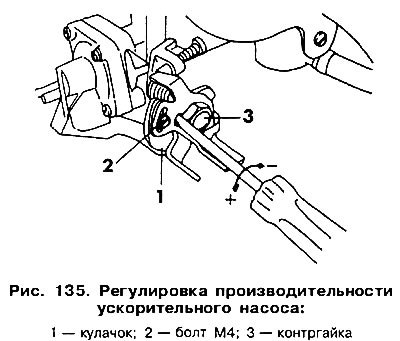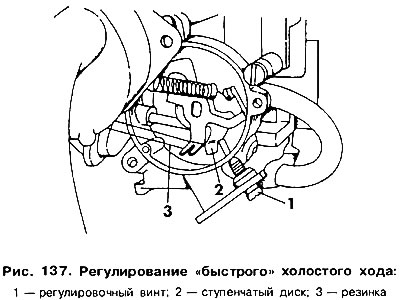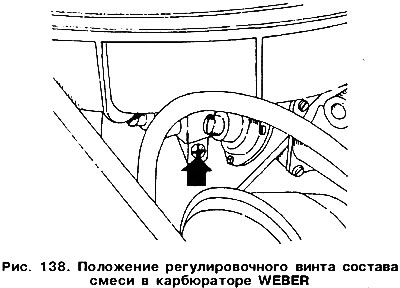Accelerator pump performance
To evaluate the performance of the accelerator pump, the carburetor must be removed from the engine. Unscrew the liquid chamber of the trigger and pull the lever that controls the trigger with a rubber band (pic. 134). This holds the adjusting screw «fast» idling from contact with the stepped disk.

Remove the carburetor cap, fill the float chamber with gasoline and reinstall the cap. Get your funnel and glass measuring cup ready.
Insert the funnel into the beaker and place the carb over the funnel.
Slowly open the damper 10 times. Each opening movement must last at least 1 second, and after the movement there must be a three-second break.
The amount of fuel collected in the beaker should be divided by 10. The result should be (1,0±0,15) cm3.
If the pump is in good condition, i.e. its diaphragm, spring, atomizer and drive lever are functioning normally, then its performance can be adjusted, but within small limits.
- Screw in bolt 2 (pic. 135), lock the cam that controls the accelerator pump.
- After removing the fuse, loosen the locknut of the adjusting bolt 3.
- Slightly loosen screw 2 and turn the cam. Turning it towards «+», we increase the performance of the pump, and in the direction «-» we reduce it.

After adjustment, tighten nut 3 and lock it.
Throttle position
The throttle position is set at the factory and the adjusting screw is sealed to maintain this position. But if, in case of emergency, it was necessary to violate the factory adjustment, it must be restored as follows.
Remove the liquid chamber of the trigger and pull the control lever with a rubber band (see fig. 134).
Remove the cap 1 from the adjusting screw (pic. 136).

Turn out the adjusting screw 2 until there is a gap between its end and the lever that limits the movement of the damper 3. Then screw in the screw until it comes into contact with the lever. To make it easier to fix this moment, it is recommended to place a strip of paper between the screw and the lever. By moving the paper up and down and at the same time turning the screw, you can accurately determine the moment of their contact.
From this position, tighten the screw an additional 1/4 turn.
Close the screw with a new cap. Adjust idle speed (see below).
Mode setting «quick» idle move
If the engine constantly stalls at idle without load, the so-called fast idling mode must be adjusted. The engine must be warm and have the correct ignition and idle settings. Connect tachometer, remove starter cover and install fast idle adjusting screw 1 (pic. 137) on the second step from the top of disc 2.

Pull back on the rubber control lever on the actuator stem 3 to hold the damper in the fully open position.
Start the engine without depressing the throttle control pedal.
Check RPM. It must constitute (2000±100) rpm If necessary, adjust its value by turning screw 1.
Adjustment of parameters of idling
Adjusting the idle speed parameters consists of setting the engine speed, as well as adjusting the content of carbon monoxide in the exhaust gases. These quantities are interdependent. Therefore, the idling frequency is first set, and then they proceed to check and possibly adjust the composition of the mixture. Before starting adjustment operations, the following conditions must be met.
The engine must be warm. Check if the choke is fully open, that is, if the choke lever touches the restrictor bolt.
All electrical consumers must be turned off, this also applies to the radiator electric fan.
Disconnect the crankcase ventilation hose from the air filter, plug its end.
The ignition must be properly adjusted.
Check the idle speed with a tachometer. It must constitute (800±50) rpm If necessary, adjust it with the adjusting screw (arrow in fig. 127).
Using a gas analyzer, check the CO content in the exhaust gases. It must be within (2,0±0,5) %. Otherwise, it must be corrected using the adjusting screw (arrow 10 fig. 138).

Connecting the ventilation hose from the cylinder block increases the CO content in the exhaust gases. This is due to the fact that oil vapors are always present in the crankcase.
After adjusting the screw, put on the blue plug.
Idle speed boost valve
In order to avoid a drop in idling speed below 700 rpm under certain engine operating conditions, a vacuum-controlled valve located in the mixture adjustment screw is activated. This opens an additional channel through which additional fuel is supplied to the carburetor, which causes an increase in idle speed. Vacuum is supplied by a double valve activated via a control device. The control of the increase in idle speed, as well as the operation of the valve built into the adjusting screw, requires a vacuum pump and must therefore be carried out by ASO VW service stations.
Setting the choke position
Launcher position (air) The dampers in a Weber carburetor can be adjusted. To do this, remove the starter cover.
Adjusting screw «quick» idle speed 1, install on the uppermost recess of the disk 2, and push the rod 3 with a screwdriver in the direction of the arrow (pic. 139).

Insert a drill with a diameter of (2,5±0,2) mm (pic. 140). Pay attention to the fact that spring 2 is not compressed. If the drill of the specified diameter cannot be inserted or it is inserted with a large gap, then the flap position should be adjusted using screw 3.


Visitor comments